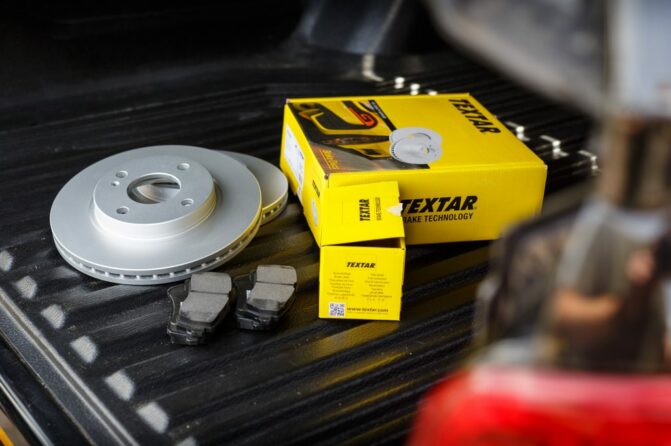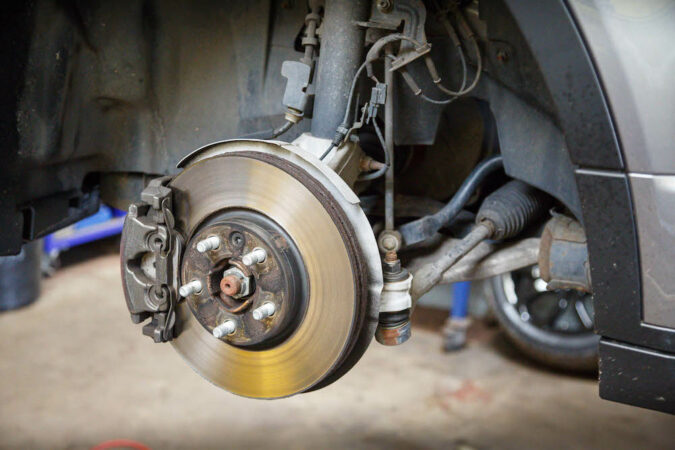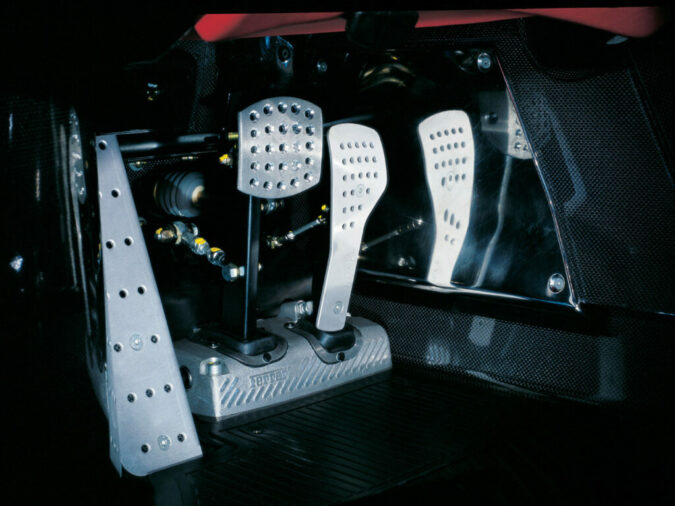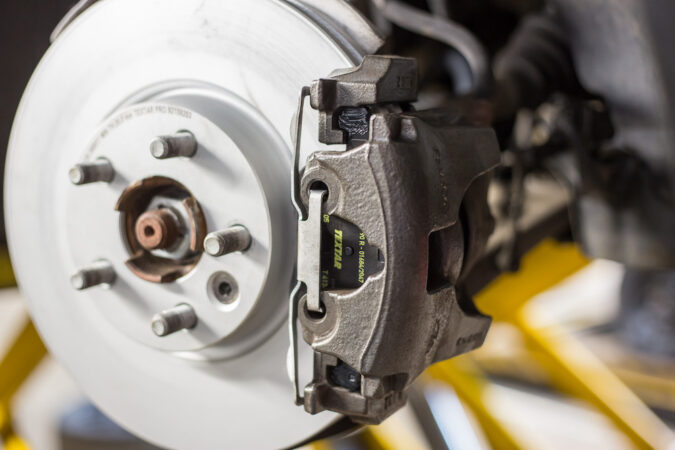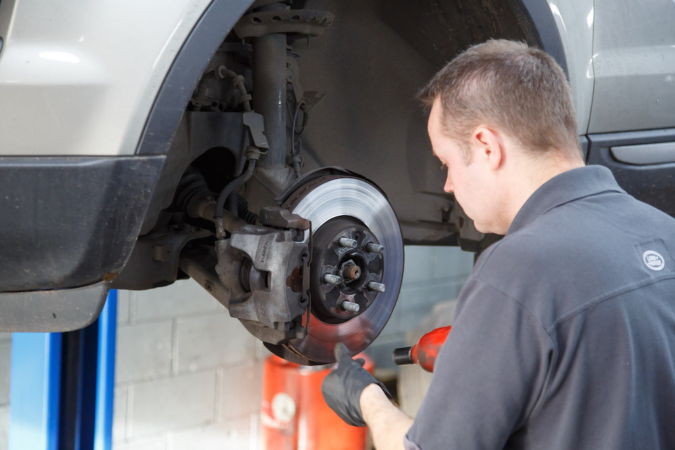The master cylinder, also known as the master brake cylinder, is a critical component of any vehicle’s braking system. Many vehicle owners take its importance for granted, and would not ensure to keep it in good shape. The braking system plays a vital role in ensuring a safe ride. And newer vehicles with an ABS system perform even better. Brakes are applied and released hundreds, if not thousands of times a day while driving.
While many factors contribute to automobile accidents, brake failure account for a large portion of car crashes in the United States. NHTSA reports show that brake-related issues caused 22% of US accidents. Brakes allow you to slow down or stop, which can help avoid a serious accident. That’s where the master cylinder comes in. It determines your braking system performance. This article shows the importance of the master brake cylinder and how best to employ its function in your car.
- Brake System
- How The Master Cylinder Works
- Brake Master Cylinder in Cars
- Types of Brake Master Cylinder
- Brake Master Cylinder Parts
- How It Impacts Performance
- Bad Master Cylinder Symptoms
- Master Cylinder Replacement Cost
- How To Replace Them
- Final Thoughts
- FAQs
The Brake System
The braking system components include a master cylinder, brake pads, a caliper, and a rotor. Once you press the brake pedal, the master cylinder sends pressurized brake fluid to the caliper.
The brake caliper presses the brake pads against the brake rotor, to slow down or halt a moving vehicle. The brake caliper receives the brake fluid sent from the brake cylinder. The entire braking system would definitely malfunction when the master cylinder becomes faulty.
Brake Master Cylinder
The pressure piston receives the power pressure of your foot whenever you press down on the brake pedal. As a result, the piston is pushed closer to the brake line.
- A pushrod drives the primary piston, which compresses the brake fluid in its circuit.
- As the primary piston travels, hydraulic pressure inside the cylinder and brake lines rises.
- This pressure drives the secondary piston, which compresses the brake fluid in its circuit.
The brake force is generated once the pressure chamber shuts from the piston collar going on top of the bore. The pressure piston in modern cars is supported by a spring. As a result, if you let go of the brake pedal, it returns to its original position. After this, the brake fluid returns to the master cylinder, disengaging the brakes.
Brake Master Cylinder In Cars
Your vehicle is equipped with two brakes, one on the front and one on the back. They work with your car’s brake pedal. When the driver presses down on the brake pedal, both are applied simultaneously; the master cylinder delivers brake fluid to the braking circuit. It converts the pressure you apply to the pedal into hydraulic pressure.
The brake cylinder transfers pressure from the brake pedal to the braking mechanism at the wheels. It controls all the braking activities in your car. Without it, braking won’t be possible. It is also able to transmit motion because the braking fluid is incompressible. Both the disc and drum brakes employ its services to function.
In a manual brake system, the brake cylinder connects directly to the firewall and is coupled to the brake pedal. It is connected to a brake booster for power-assisted brakes, which provides more power to the braking system. The brake pedal is linked to the booster and the engine compartment’s firewall.
Types Of Master Brake Cylinder
Brake master cylinders are in two categories based on their construction and applications.
Types Of Master Brake Cylinder #1-Master Cylinder With A Single Circuit
A single circuit master cylinder transmits equal force to all wheels due to the usage of a single-cylinder single piston or circuit. In hydraulic braking systems, its storage tank stores the brake fluid. These cylinders are found in two-wheelers such as the Bajaj Pulsar and TVS Apache and a few lightweight four-wheelers such as e-rickshaws.
Types Of Master Brake Cylinder #2-Tandem Master Cylinder
It’s a modified master cylinder with multiple cylinders, dual pistons, single-cylinder twin pistons, and a dual circuit. The other circuit will stop the car (which controls the other pair). It is more efficient than the single circuit variant. They are found in every vehicle with a hydraulic braking system.
A tandem master cylinder offers independent or diagonal braking between the front and rear wheels, an important safety characteristic for vehicles.
Brake Master Cylinder Parts
The master cylinder parts include:
1. Proportioning Valve
This valve makes the drum brakes engage first, before the disc brakes. This applies to vehicles with disc brakes on the front wheels and drum brakes on the rear wheels.
2. Primary And Secondary Pistons
The primary piston triggers when you press down on the brake pedal; it also presses down as you press harder on the brake pedal, and pressure in the brake cylinder increases. The secondary piston’s duty is to compress the brake fluid in line with the increase and decrease in the pressure between the primary and secondary pistons.
3. The Filler Cap
The brake fluid reservoir’s filling lid allows the fluid to fluctuate without producing pressure. Keep the top closed to avoid dust or moisture from entering to contaminate the fluid.
4. The Fluid Level Sensor
It aids in keeping track of the amount of fluid in the braking reservoir. When a pressure imbalance occurs, your brake light will be on, alerting you of the need to inspect the reservoir.
5. Pushrod
A lever and a piston are connected to the pushrod. When the brake lever is squeezed, it pushes the piston into the bore and slides.
6. Hosepipes
The braking fluid is transferred from the master cylinder assembly to the caliper assembly via a tube-type pipe.
7. Returning Spring
It’s a coil spring in the cylinder to keep the piston and brake pedal in place once the brake pedal is released.
8. Master Cylinder Reservoir
In a hydraulic braking system, the storage tank holds the brake fluid. The reservoir is positioned at its top. You must sufficiently fill the brake system with brake fluid to prevent air from entering the system.
How Does The Brake Master Cylinder Impact Braking Performance
The bore diameter of the master cylinder has a significant impact on braking performance. The overall sensation of the brake pedal and the amount of brake pressure applied are affected by the cylinder diameter. Resulting in things like:
- Hard brake pedal: You’ll have to work harder to push the brake pedal.
- Short brake pedal stroke: The brake pedal does not travel far enough to create braking pressure. Due to the excessive resistance, you’ll have to tap the brakes hard, causing the brakes to engage fast, resulting in a jumpy car.
- Soft brake pedal: Less effort is needed to push the brake pedal.
- Long-stroke: Press the brake pedal down to provide braking pressure. The brake pedal will feel less resistance, but you’ll have to press down harder for the brakes to operate. That is not a good setting if you’re stuck in traffic or need to make a fast stop.
Bad Master Cylinder Symptoms
Knowing the functions of the brake cylinder in your car makes it easier to detect master cylinder problems. Some of the problems include external leaks, internal leaks, and valve issues. Bad master cylinder or brake booster symptoms will become plain when the entire brake system begins to fail. However, it is better to detect its initial warning signs to avoid road accidents. The following are the obvious signs that you have a bad master cylinder.
1. Brake Fluid Leak
The master brake cylinder requires a set amount of hydraulic pressure from the fluid to slow down a car. Brake fluid levels are almost always low when the cylinder is leaking braking fluid or if there are unsecured reservoirs on the cylinder. Examine the vacuum booster input seal or pushrod misalignment to identify the source of the fluid leak.
Your safety on the road is uncertain if your brake fluid level drops to a dangerously low level. If the issue results from a bad master cylinder, go for a replacement.
2. Engine Light Illuminate And Warning Light
Brake fluid level and pressure sensors are fitted in the master cylinder of newer vehicles. In the event of a sudden loss in hydraulic pressure, these sensors will notify the driver on the dashboard. That indicates an issue with the braking system, but the master cylinder itself may not be at fault.
However, if sensors in the braking system detect a decline in brake fluid pressure, it is most likely due to a bad master cylinder. In this case, the alarm will go off. A leaking master cylinder will make the ABS light flash on the dashboard if the master cylinder is working.
3. Spongy Brake Pedal
If the brake pedal begins to feel spongy when you apply pressure on the pedal, it indicates a malfunctioning master cylinder. Rubber seals in the cylinder keep the brake fluid. Maintain the rubber seals to avoid an internal brake fluid leak in the master cylinder.
4. Contaminated Brake Fluid
Another issue that could arise from old rubber seals is the contamination of the brake fluid. The seals prevent dirt and debris from contaminating the fluid, preventing the braking fluid from leakage.
When you step on the brake pedal, you won’t feel as much pressure as you would if this were to happen. Brake fluid should be clear, golden yellow to brown, and should not be cloudy. Something is wrong if your brake fluid turns a dark brown or black color.
5. Sinking Brake Pedal
Following previous symptoms, you may notice that the brake pedal does not return to the top position after taking your foot from it. If the master cylinder does not release pressure, you’ll feel abnormalities with the brake pedal. Fix the brake cylinder fast, as that can be risky when it happens on the highway.
6. Bad Brake Bias
Two distinct circuits are commonly found in master cylinders, allowing braking fluid to route to the wheels in pairs. If one part of the system leaks, the brakes will no longer work. The circuit controls one front wheel and the opposing rear wheel.
The vehicle may pull to one side during braking if one of the circuits has failed. When you brake forcefully, the front brakes add more pressure than the rear brakes to bring the vehicle to a halt.
7. Uneven Brake Pad Wear
You’ll notice uneven pad wear if only two of the four wheels can apply the brakes due to a faulty circuit. The front right and rear left would wear out more than their front and rear right counterparts. A piston seal failure or a leak in the braking lines could trigger a circuit failure. The master cylinder could be responsible for uneven braking, uneven pad wear, or a car that pulls to one side when braking.
Brake Master Cylinder Replacement Cost
The brake cylinder has seals on the interior and exterior that might wear out over time. A flush, replacement, and bleeding of the brake fluid are necessary to keep the brake system running.
The master cylinder replacement will cost between $250 to $600. The type and model of your car make the cost vary as it determines the costs of the parts required. Brake fluid is included in the cost of the replacement master cylinder, which ranges from $100 to $300. The labor cost could range from $100 to $300 based on your vehicle model.
Brake Master Cylinder Replacement
When changing a master cylinder, bench bleeding the new unit before installing it in your car is good. That is good for angled master cylinders, which trap air in the front chamber. To bench-bleed the master cylinder, you’ll need to set up a return channel that allows the fluid from the discharge ports to flow back to the fluid reservoir.
You may buy and use a master cylinder bleeder kit with plastic fittings and a hose. Another option is to make your return pipes out of flexible tubing and fittings that suit the discharge ports. Follow these steps to get the job done.
- Unplug the brake booster and the braking lines.
- Dismantle the old master brake cylinder
- Connect brake lines to the booster, and install the master cylinder unit.
- Get rid of the old fluid and air in the brake system.
Brake Master Cylinder Facts:
- The brake master cylinder converts the pressure you place on the brake pedal into hydraulic pressure that slows down your vehicle using brake fluid.
- All braking systems, whether they use disc brakes or drum brakes, require a brake master cylinder to function.
- Symptoms of a bad brake master cylinder include warning lights on the dashboard, brake fluid leaks, spongy brake pedals, contaminated brake fluid, and sinking brake pedals.
- A bad brake master cylinder can also cause brake bias issues and uneven brake pad wear.
- If you notice any of these symptoms, it is important to address the problem immediately, as it is dangerous to drive without properly functioning brakes.
- The cost to replace a brake master cylinder can range from $320 to $500, with labor costs being the most expensive part of the replacement.
- Brake master cylinder replacement is a job that requires a good amount of automotive repair experience, and if you are not comfortable performing the repair yourself, it is best to bring your vehicle to a trusted mechanic.
- Brake systems need to be bled after replacing the brake master cylinder to ensure proper function, and ABS systems can be tricky to bleed.
- Brake fluid leaks or unsecured reservoirs on the brake master cylinder can result in low brake fluid levels, impairing your ability to slow down the vehicle.
- The brake master cylinder contains rubber seals that prevent brake fluid leaks and debris from contaminating the brake fluid. Worn-out seals can cause spongy brake pedals and contaminated brake fluid.
Final Thoughts On Master Brake Cylinder
As complex as master cylinders may appear, they’re simple to install and maintain. Your entire braking system could be at risk if the brake cylinder is faulty, as all your inner brake components rely on it. Your car’s hydraulic system relies heavily on the master cylinder.
The hydraulic pressure is applied to the brakes by converting the force applied to the brake pedal. Contact your mechanic if you detect any fault with your brake system; the moment you see indicators that it is failing, have it fixed as soon as possible. Accidents are worse than a few hundred bucks.
Frequently Asked Questions About Master Brake Cylinder
Here are some popular FAQs:
What Is A Brake Master Cylinder
The brake master cylinder is a part of your car’s braking system that transfers pressure from the brake pedal to the braking mechanism at the wheels. It’s the brains of your vehicle’s braking system. Without a brake master cylinder, no braking system would be possible.
How Do You Test A Brake Master Cylinder
You can test the brake master cylinder in the car or on the bench. For in-car testing, pump the brake system a few times and hold. If the brake pedal is spongy, this could indicate air remaining in the lines or a mechanical problem, like the brake caliper slider. Bleed the brake system again and verified the calipers were moving freely. For on-the-bench testing, use a screwdriver to press and hold the plunger in the rear of the master cylinder. The plunger should be very firm. If the plunger keeps moving, there is a fault. One of the internal seals is likely bad.
How To Replace Brake Master Cylinder
You replace the brake master cylinder by locating the various components of the vehicle’s brake system. Remove the brake fluid from the brake fluid reservoir and the brake fluid sensor connector. Remove the brake fluid lines and detach the brake master cylinder. Finally, Install the new brake master cylinder and ensure its well seated.
How Does A Brake Master Cylinder Work
The master cylinder contains the brake fluid. It applies hydraulic pressure to all four wheels. The hydraulic fluid transmits pressure from the master cylinder to the four-wheel cylinders through the tubing and hoses. Foot brake pedal movement applies hydraulic pressure to all the hydraulic system components. That moves the brake pads against rotating discs or drums and creates friction. This slows down and stops a vehicle by applying pressure to the rotors.
How To Bleed Brake Master Cylinder
To bench-bleed, remove the master cylinder from the vehicle. Use a screwdriver to push the primary piston as far into the master cylinder as it will go using a large amount of torque. Remove the air from the reservoir. Allow the piston to return by releasing the pressure on the primary piston. Keep pressing the primary piston. You want to be unable to push the piston in after only one or two engine strokes. You can tell if all the air has been drained from the master cylinder when the primary piston does not move inward. We also recommend bleeding new cylinders before installation.
How Much Is A Brake Master Cylinder
A new brake master cylinder would cost anything from $100 to $400 based on the type and model of your car. The cost of replacement would vary from $250 to $700.
How To Tell If Brake Booster Or Master Cylinder Is Bad
The brake booster is likely bad if the brake warning light on the dashboard keeps shining. Other visible symptoms include: leaking brake fluid, uneven pad wear, spongey brakes, and a sinking brake pedal: if the brake master cylinder is not releasing the pressure like it normally does, you’ll feel abnormalities with the brake pedal. You’ll notice uneven pad wear if only two of the four wheels can apply the brakes due to a faulty circuit. When you apply the brakes, it could manifest as an engine misfire or stalling.
How To Rebuild A Brake Master Cylinder
To rebuild the brake master cylinder, remove the device from the car, then dismantle it to get to the parts. Clean the metal components to a pristine condition. Clean and dry the pistons and internal surfaces. Verify that the device’s body is free of flaws to know if there is a need for replacements. Then install new seals. Ensure everything is working well before reinstalling; take a spin around the block and re-inspect the system.
How To Check Brake Master Cylinder
Apply pressure to the brake pedal to a halt and then keep it there, allowing the vehicle to come to a rest. You should replace the brake cylinder if the brake pedal begins to slip back down after halting.
Which Port On Master Cylinder Goes To Front
It depends on the brake system’s design. The front brakes are usually handled by the first part closest to the brake pedals in older automobiles. The second session handles the rear brakes. Many recent cars have a dual-diagonal setup. The right front wheel brake is on the same circuit as the left rear, and the left front is matched with the right rear, both with a proportioning valve to lower pressure going to the rear brakes. Anti-lock braking systems (ABS) add more hardware to the equation.
How To Tell If Master Cylinder Is Bad
To diagnose a bad master brake cylinder, check your brake fluid leak to know if it is contaminated. Most vehicles have a Warning brake light on the dashboard. The master cylinder could be faulty if the light keeps shining. Other signs include Spongy brake pedals, uneven brake pads wear, and sinking brake pedals.

